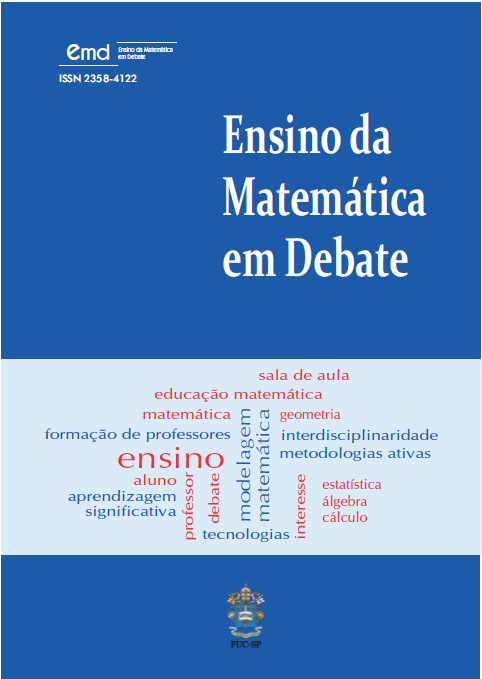From exercise to problem: The potentialization of semiotic representation registers by GeoGebra
Potenciando los registros de representación semiótica por GeoGebra
Keywords:
Semiotics Representations, Problem Solving, GeoGebra, GeometryAbstract
This article presents the analysis of an experiment on solving a mathematics exercise in the classroom involving calculating the area of a rhombus and transforming it into a mathematics problem using Duval's Theory of Registers of Semiotic Representation. More precisely, we intend to show through this experience that the GeoGebra dynamic geometry software contributes to the transition from an exercise to a problem, a transition that is based on the exploration and mobilization of different treatments and conversions into different semiotic representations. The activity was developed in a class of second-year high school students, with the use of GeoGebra being fundamental for a more dynamic study of the geometric object, allowing students to manipulate the object, identify elements and enrich the figure with different geometric objects. The analysis of this approach shows that GeoGebra enhances both the construction of treatments in the figural register and the interaction of students with the object, enabling a new look at some geometry topics and a more active participation in the production of knowledge.
References
AMADO, N.; SANCHEZ, J.; PINTO, J. A utilização do geogebra na demonstração matemática em sala de aula: o estudo da reta de euler. Bolema: Boletim de Educação Matemática, v. 29, p. 637–657, 2015. Disponível em: https://www.scielo.br/j/bolema/a/J6bmB3dJXBdy8J3MwpjFC6x/?format=pdf&lang=pt. Acesso em: 10, out. 2023.
BARBOSA, L. S.; MENEGHETTI, C. M. S.; POFFAL, C. A. O uso de geometria dinâmica e da investigação matemática na validação de propriedades geométricas. Revista Ciência e Natura. UFSM, Santa Maria, v. 41, 2019. Disponível em: https://periodicos.ufsm.br/cienciaenatura/article/download/33752/e12?inline=1#_bookmark54. Acesso em: 10, out. 2023.
BORSOI, C. GeoGebra 3d no ensino médio: uma possibilidade para a aprendizagem da geometria espacial. 2016. 159f. Dissertação (Mestrado Profissional em Ensino de Matemática) – Instituto de Matemática e Estatística da Universidade Federal do Rio Grande do Sul. UFRGS, Porto Alegre-RS. 2016. Disponível em: https://www.lume.ufrgs.br/handle/10183/148179. Acesso em: 13, out. 2023.
BRASIL, Ministério da Educação. Parâmetros Curriculares Nacionais: Matemática. Brasília: MEC/SEF, 1998.
BRASIL, Ministério da Educação. Base Nacional Comum Curricular. Brasília: MEC, 2018.
DANTE, L. R. Didática da resolução de problemas de matemática. São Paulo: Ática, 1998.
DOLCE, O; POMPEO, J. N. Fundamentos de matemática elementar 9: Geometria plana. São Paulo: Atual, 2013.
DUVAL, R. Registros de representação semiótica e funcionamento cognitivo do pensamento. REVEMAT: Revista Eletrônica de matemática, v. 7, n. 2, p. 266–297, 2012. Disponível em: https://periodicos.ufsc.br/index.php/revemat/article/view/1981-1322.2012v7n2p266. Acesso em: 10, out. 2023.
DUVAL, R. Questões epistemológicas e cognitivas para pensar antes de começar uma aula de matemática. REVEMAT: Revista Eletrônica de matemática, v. 11, n. 2, p. 1–78, 2016. Disponível em: https://periodicos.ufsc.br/index.php/revemat/article/view/1981-1322.2016v11n2p1. Acesso em: 10, out. 2023.
ECHEVERRIA, M. D. P. P.; POZO, J. I. Aprender a resolver problemas e resolver problemas para aprender. In: POZO, J. I. (Org.). A solução de problemas: Aprender a resolver, resolver para aprender. Porto Alegre: Artmed, 1998. p. 13-42.
FREITAS, J. L. M. de; REZENDE, V. Entrevista: Raymond Duval e a teoria dos registros de representação semiótica. Revista Paranaense de Educação Matemática, v. 2, n. 3, p. 10–34, 2013. Disponível em: https://periodicos.unespar.edu.br/index.php/rpem/article/view/5946. Acesso em: 10, out. 2023.
GIL, A. C. Como elaborar projetos de pesquisa. São Paulo: Atlas, 2002.
GRAVINA, M. A. O potencial semiótico do geogebra na aprendizagem da geometria: uma experiência ilustrativa. VIDYA, v. 35, n. 2, p. 18, 2015. Disponível em: https://periodicos.ufn.edu.br/index.php/VIDYA/article/view/605/561. Acesso em: 10, out. 2023.
HENRIQUES, A.; ALMOULOUD, S. A. Teoria dos registros de representação semiótica em pesquisas na educação matemática no ensino superior: uma análise de superfícies e funções de duas variáveis com intervenção do software Maple. Ciência & Educação, v. 22, n. 2, p. 465–487, 2016. Disponível em: https://www.scielo.br/j/ciedu/a/QVbBDvRRtjvVXD6HXFYXcxx/?format=pdf&lang=pt. Acesso em: 10, out. 2023.
HESPANHOL, L. L.; NICOLA, L.; SILVA, C. R. B. da; SANTOS, C. M. F. dos; RIBEIRO, E. M. P. A utilização do software GeoGebra para o ensino da geometria. XII ENEM–ANAIS ENCONTRO NACIONAL DE EDUCAÇÃO MATEMÁTICA, São Paulo, 2016. Disponível em: https://www.sbembrasil.org.br/enem2016/anais/pdf/6276_4233_ID.pdf. Acesso em: 10, out. 2023.
MENDES, C. J. O uso do geogebra 3d no ensino de geometria. 2020. 82f. Dissertação (Mestrado Profissional em Matemática em Rede Nacional) – Departamento de Matemática da Universidade de Brasília. UnB, Brasília-DF. 2020. Disponível em: https://sca.profmat-sbm.org.br/profmat_tcc.php?id1=5374&id2=171052843. Acesso em: 10, out. 2023.
ONUCHIC, L. R.; ALLEVATO, N. S. G. Pesquisa em resolução de problemas: caminhos, avanços e novas perspectivas. Bolema – Mathematics Education Bulletin, v. 25, n. 41, p. 73–98, 2011. Disponível em: https://www.periodicos.rc.biblioteca.unesp.br/index.php/bolema/article/view/5739. Acesso em: 10, out. 2023.
PACHECO, E. F. Utilizando o software GeoGebra no ensino da Matemática: uma ferramenta para construção de gráficos de parábolas e elipses no 3° ano do Ensino Médio. Debates em Educação, v. 11, n. 24, p. 197–211. Disponível em: https://www.seer.ufal.br/index.php/debateseducacao/article/view/6905. Acesso em: 14, abr. 2024.
POLYA, G. A arte de resolver problemas. Rio de Janeiro: Interciência, 2006.
SILVA, E. P. da. GeoGebra no ensino de quadriláteros: uma proposta de sequência didática. Trabalho de Conclusão de Curso (Licenciatura em Matemática) – Universidade Federal de Campina Grande. Cuité-PB. 2023. Disponível em: http://dspace.sti.ufcg.edu.br:8080/jspui/handle/riufcg/30945. Acesso em: 13 out. 2023.
SOUSA, R. T. de; AZEVEDO, I. F. de; ALVES, F. R. V. O GeoGebra 3d no estudo de projeções ortogonais amparado pela teoria das situações didáticas. Jornal Internacional de Estudos em Educação Matemática, v. 14, n. 1, p. 92–98, 2021. Disponível em: https://jieem.pgsscogna.com.br/jieem/article/view/8941. Acesso em: 13, out. 2023.
Downloads
Published
How to Cite
Issue
Section
License
Copyright (c) 2024 Ensino da Matemática em Debate

This work is licensed under a Creative Commons Attribution-NonCommercial 4.0 International License.

Este obra está licenciado com uma Licença Creative Commons Atribuição 4.0 Internacional.





